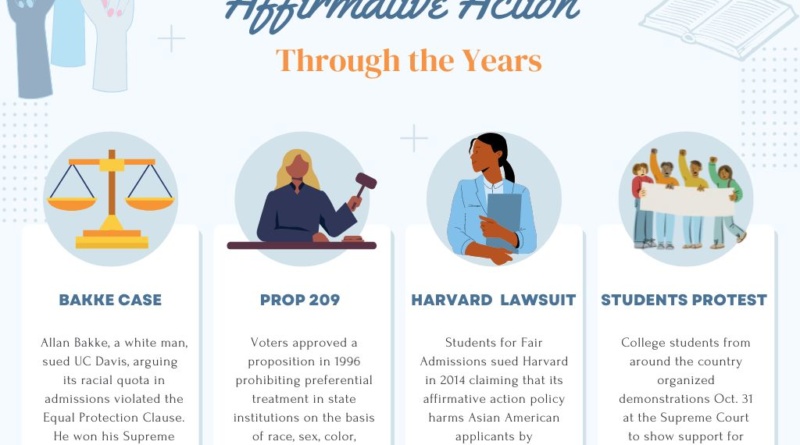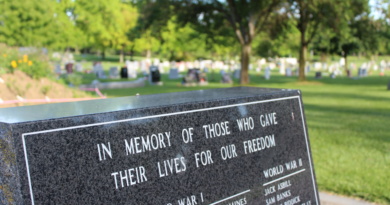UC in the spotlight as affirmative action set to be overthrown
Graphic By Xochitl Armién
By Max Davis-Housefield
BlueDevilHUB.com Staff–
With the future of affirmative action uncertain, universities across the country are turning their eyes to the UC system, according to UC Davis Law professor and Chancellor’s Fellow Brian Soucek.
“I think other schools like Harvard and UNC (University of North Carolina)… will be, and already are, looking to us to see what else they could do,” he said.
Affirmative action was made illegal in California after voters approved Proposition 209 in 1996. 55% of voters voted for the measure. It survived an attempted repeal in 2020 with 57% of voters voting against the repeal.
“Opponents of affirmative action point to the University of California system (which is), as far as I know, the most diverse public university (system) and the most diverse elite university in the world (even after proposition 209),” Soucek said.
But the UC has worked hard to build this diversity. “It’s forced us to be more creative in how we maintain diversity without directly taking account of race,” Soucek said.
The most successful thing the system does to maintain diversity is its Eligibility in the Local Context (ELC) program which guarantees admission to the top 9% of students from each high school in the state.
“The reason why it works well is because our high schools, like our neighborhoods, are so racially segregated.… Is it effective in helping bolster our diversity? Yes. Is that an unambiguously great thing? No. It’s actually taking advantage of some of the racial dynamics that afflict us,” Soucek said.
Additionally, targeted recruiting of students allows the system to increase its diversity. At the graduate and professional levels, that means recruiting from historically black colleges and universities. It can also mean targeting different zip-codes and socioeconomic levels.
Joy Klineberg, a parent at DHS and the chair of the DHS PTA’s College Access Committee wishes the UC would be more transparent about how they are ensuring diversity.
“Every school (is) saying that diversity is their priority, but the applicants are left wondering if it really is and how are they weighing it if they aren’t allowed to factor race in,” Klineberg said.
The Supreme Court is expected to rule against Harvard’s use of affirmative action when it releases its decision in Students for Fair Admissions v. Harvard. Soucek expects a 6-3 ruling with all of the conservative justices siding with the students who are claiming that Harvard’s affirmative action violates their constitutional rights.
“The only real question is how far the court is able to go in something that conservatives on the court have wanted for a long time now, which is to say that the constitution is color blind,” Soucek said.
If the court rules against affirmative action, the effects won’t only be felt in higher education. Affirmative action is used in government contracting where minority owned businesses are given preference and to some extent by private employers where they can prioritize minorities in the hiring process to increase diversity in the workforce.
The court currently stands at a unique point in the history of affirmative action that makes it even more likely they will overturn it.
The first affirmative action case was heard by the court in 1978. Allan Bakke, a white man, claimed that UC Davis medical school was discriminating against him in its use of affirmative action to admit a less qualified minority applicant. The swing vote, Justice Powell, broke a 4-4 tie and essentially decided the case.
The court’s ruling said that the UC’s use of quotas was unconstitutional, but it didn’t completely forbid affirmative action.
“It had to be used in a holistic way. It couldn’t be like a set score, you know, you get five bonus points on the spreadsheet for being an underrepresented minority,” Soucek said.
The next challenge to affirmative action came 25 years later, this time from a white student denied admission to the University of Michigan Law School. As the new swing judge, Justice O’Conner was the deciding vote this time around.
According to Soucek, Justice O’Connor essentially said: “It’s been 25 years since Bakke. We hope that in another 25 years these kinds of racial preferences will no longer be needed.”
During oral arguments in Students for Fair Admissions v. Harvard, the court has been grappling with Justice O’Connor’s comments.
“The 25 years would come due in 2028… if this was supposed to end in 25 years, should we just call it now?” Soucek said, explaining their logic. But O’Connor’s words are not exactly a legal rule, he added.
Soucek believes that affirmative action is still needed to preserve diversity.
“Some universities have created these problems for themselves by insisting on a set of criteria that actually disfavor African-American and Hispanic applicants,” Soucek said.
Schools that consider legacy admissions, family donations, high performing athletes, the SAT, and even obsess over their own US News rankings are making it harder to achieve diversity.
“Each of these factors is having what we call a racially disparate impact on the very groups that these universities are quite rightly saying they want to fully include,” Soucek said. Soucek wishes the court would consider these challenges for minorities in their ruling. “If you want to explicitly take account of race in admissions, you are first going to have to stop doing these things,” Soucek said, describing a ruling he would be happy with.



